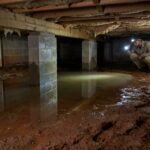Essential Guide to Foundation Repair: Protecting Your Home from Hidden Dangers
When it comes to homeownership, many of us are focused on aesthetics—picking the right paint color, choosing the perfect tile, adding that oh-so-charming porch swing. But while you’re busy making your home look fabulous, one crucial element is lurking beneath your feet: the foundation. Yes, that unsung hero holding up everything you cherish is subjected to a lot more than just your living room furniture. It’s time to dive into the essential guide to foundation repair and uncover the hidden dangers that could jeopardize your sanctuary.
Understanding Your Foundation
First things first: what exactly is a foundation? In simple terms, it’s the concrete or masonry structure upon which your house stands. Think of it as the sturdy base of a cake—you wouldn’t want to find out your cake is supported by whipped cream, would you? Foundations come in various types, including slab, crawl space, and basement, each with its own unique benefits and potential pitfalls.
Slab foundations, for example, are poured directly onto the ground and can suffer from issues related to soil movement and moisture. On the other hand, crawl space foundations allow access to plumbing and electrical systems but often fall victim to mold and critters. Basements provide added storage space (or an exciting venue for your next “haunted house” party), but they can also become waterlogged nightmares.
The Importance of Foundation Integrity
To appreciate why foundation repair is essential, let’s consider what’s at stake. A compromised foundation can lead to severe structural issues, both inside and outside your home. Cracks in walls, doors that stick like they’re auditioning for a role in a horror movie, and uneven floors are just a few signs that your foundation may be in distress. If left unchecked, these problems can escalate quickly—no one wants their living room to resemble a call to an earthquake recovery center!
Additionally, a weakened foundation can lead to costly repairs down the line. It’s much more economical to address foundation issues early than to deal with the fallout of a full-blown structural failure. So, when it comes to your home, a strong foundation truly is the best foundation for your future.
Signs Your Foundation Needs Attention
Now that we’ve established how vital a healthy foundation is, let’s look at some warning signs that something might be amiss:
1. **Cracks in Walls and Ceilings**: If your walls start looking like a spider web, it’s time to investigate. While small cracks can be normal due to settling, large cracks or those that expand over time signal deeper issues.
2. **Doors and Windows That Stick or Won’t Close**: Ever feel like your front door has a mind of its own? If it’s suddenly rebellious and refuses to close, your foundation might be shifting.
3. **Uneven or Sagging Floors**: If you find yourself practicing your tightrope walking skills in your living room due to sloped floors, this isn’t just an accidental design choice—it’s a sign of potential foundation failure.
4. **Moisture in the Basement or Crawl Space**: Dampness or puddles can indicate drainage issues that could erode your foundation. Plus, they make excellent homes for mold and other undesirable guests.
5. **Gaps Between Walls and Floors**: If you notice gaps developing between your walls and floor, your home might just be trying to tell you something important.
If you notice any of these tell-tale signs, don’t wait for a foundation crisis to strike. Addressing these issues sooner rather than later can save you from extensive repairs and hefty bills.
Assessing the Causes of Foundation Damage
So, what causes that seemingly innocent foundation to turn against you? Several culprits threaten your home’s stability:
1. **Soil Conditions**: The type of soil under your foundation plays a significant role in its integrity. Expansive clay soil can swell when wet and shrink when dry, causing foundation movement. Conversely, sandy soil drains well, but it can erode over time, leading to instability.
2. **Poor Drainage**: Water is both friend and foe when it comes to foundations. If water pools around your home instead of draining away, it can saturate the soil. This can create hydrostatic pressure against your foundation, leading to cracks and shifts.
3. **Tree Roots**: Those majestic trees in your yard are beautiful until their roots decide to dig beneath your foundation. As they grow, they can cause upheaval that affects your home’s stability.
4. **Heavy Landscaping**: Installing large flower beds or terraces can increase the weight above your foundation. If not properly supported, that extra load can lead to problems.
5. **Construction Issues**: Sometimes, it’s not you—it’s them. Poor construction practices, such as inadequate drainage or improper footing depth, can set you up for foundation failure.
Foundation Repair Methods
If you’ve identified a foundation problem, fret not! There are several methods to reinforce and repair your foundation:
1. **Crack Injection**: For minor cracks, crack injection is a common solution. This involves injecting epoxy or polyurethane foam into the cracks to seal and stabilize them.
2. **Piering**: If your foundation has settled or shifted significantly, piering might be necessary. This process involves inserting steel piers into the ground beneath your foundation, providing additional support.
3. **Helical Piers**: Similar to traditional piers, helical piers are twisted into the ground to support foundations experiencing significant settlement. They resemble giant screws—perfect for anyone who loves a good DIY analogy.
4. **Slabjacking**: For sunken slab foundations, slabjacking (also known as mudjacking) involves pumping a mixture beneath the slab to raise it back to its original position. It’s like giving your foundation a little lift—and we all love a good lift!
5. **Water Diversion Solutions**: If water pooling around your foundation is a prime suspect, consider installing French drains, gutters, or downspout extensions to redirect water away from your home.
DIY vs. Professional Help
While some homeowners might be tempted to tackle foundation repairs themselves—a noble endeavor, indeed—it’s essential to recognize when to call in the pros. Minor repairs, such as sealing small cracks, can be a DIY project for the ambitious homeowner. However, significant issues usually require the expertise of foundation repair specialists. Not only do they have the experience to diagnose the cause of the problem, but they also possess the tools necessary to implement long-lasting solutions.
In Summary
Your foundation is the backbone of your home, and protecting it should be a top priority. By recognizing the signs of foundation trouble early, understanding the causes behind foundation damage, and knowing the repair options available, you can safeguard your investment against hidden dangers.
Remember, a solid foundation means peace of mind—a place where you can enjoy family gatherings, host friends, and fully relax without worrying if your home will someday resemble a scene from a disaster movie. Go ahead, invest in your foundation; after all, when it comes to protecting your home, there’s no place like a strong foundation.


